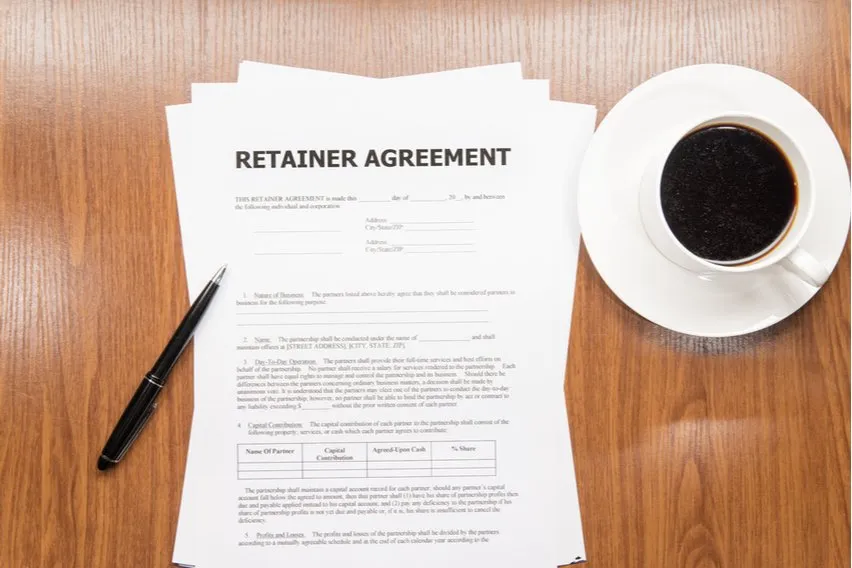What Is a Retainer Agreement?

Contractors have to consistently find new projects to keep afloat. Retainer agreements could be the answer to sustainable income.
Being a freelancer or contractor is a bit of a feast or famine. It’s great to have the flexibility to work with a wide range of clients. The downside is you can have a busy month and a quiet month. The rollercoaster of self-employment.
Retainer agreements are the closest thing we get to being “employed” as self-employed business owners. Read on to understand how they work and if they are suitable for your style of business.
Here’s What We’ll Cover:
The Definition of Retainer Agreement
The Two Types of Retainer Agreements
What are the benefits of having a retainer agreement?
What are the limitations of having a retainer agreement?
The Definition of Retainer Agreement
A retainer agreement is a long-term contract of work between a company and a contractor. A client would hire you on an ongoing basis for a set amount of work that you agree upon together.
The major elements of a retainer agreement:
- It is a long-term contract
- You are not employed by the client or company. You are still operating as a contractor. So you don’t receive the same employment benefits as full-time employees.
- Your agreement may entail a certain amount of work, e.g. a number of hours to fulfill every month.
- Your agreement can be for a set period of time, like 6 months, or indefinite.
- Retainer agreements include a retainer fee. These could be monthly payments, weekly payments or even advance payment. The payment structure is decided before signing the contract.
The most well-known professionals to work on retainer are lawyers. A company will hire a lawyer and pay a monthly fee for their services instead of ad-hoc consulting.

The Two Types of Retainer Agreements
- Pay for hire
Pay for hire retainer agreements link your rate to a set number of hours or deliverable work. For example, a client may hire you as a photographer to take 10 social media photos for them every month. You would get a set monthly fee for those deliverables.
This works well for contractors who work with hourly rates. You can set a monthly rate and a payment plan for ongoing work. - Pay for access
Pay for access is a bit more fluid. There are no contracted hours or deliverables per se. You are hired for your expertise. The client would like you to be available when they need your help. This is the legal professional retainer model. You may not always need your lawyer for 10 hours every month, but you’d like to know that they will be there when legal services are required.
What are the benefits of having a retainer agreement?
- Stability
You know that you will have regular income from at least one source. This is invaluable when you run your own business on a work-to-hire basis. You’ll have less necessity for inbound marketing. Invoicing clients is easy. You can also more effectively budget your cash flow and grow your business with the security of that sweet retainer fee. - Consistency
Somewhat related to the first point, you can build a long-term, retainer relationship with clients. It is great to have this! You can develop a real connection with your clients, understanding their needs and building rapport. This is harder to do if you are on the customer hamster wheel all of the time.
The consistency for clients is helpful too. If your client knows you will be working with them for set hours every week or month, they feel more at ease. They can plan their tasks better and feel assured you will be assisting them consistently. - Better rates for clients
You may price your services slightly differently for long-standing client relationships. You can call this a retainer discount. This is advantageous for the client as they are getting your reliable service at a good rate.

What are the limitations of having a retainer agreement?
I could have called this section the “drawbacks” of retainer agreements. But honestly, limitations are more fitting.
Most freelance professionals agree that having clients on retainer is preferable to ad-hoc work. The consistent paycheck and strong bond with clients are too good to pass up.
However, it is somewhat limiting to be tied into a contract for certain hours on a monthly basis. It gives you less flexibility to take on other bigger projects outside of your retainer contract.
Client off-boarding is more complicated with a freelance retainer contract too. You have to have a break clause written into your contract in case there is a breakdown of relationship during the retainer project.
Key Takeaways
A retainer agreement can bring you predictable income and good client relationships. To master retainer agreements, be sure to negotiate your exact scope of work and a great rate of pay that works for both parties.
We hope this guide was helpful in helping you decide whether a retainer arrangement could be for you. Find more like this on our resource hub.
RELATED ARTICLES

 What Is a POS System (Point of Sale)? A Guide on How It Works
What Is a POS System (Point of Sale)? A Guide on How It Works Per Diem Meaning: What You Need to Know
Per Diem Meaning: What You Need to Know What Is Copyright Infringement? How To Avoid Copyright Infringement
What Is Copyright Infringement? How To Avoid Copyright Infringement What Is a Purchase Requisition & Why Is It Important?
What Is a Purchase Requisition & Why Is It Important? What Is a Business Advisor?
What Is a Business Advisor? Wholesale vs Retail: What’s the Difference?
Wholesale vs Retail: What’s the Difference?